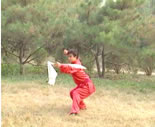|
Chuo Jiao (戳腳, literally
"poking foot") originated in the Northern Song Dynasty (960–1127) and became
popular during the Ming and Qing Dynasties (1368–1911).It comprises many
jumps, kicks, and fast fist sequences. The fist and feet work in unison and
strike continuously forward, like “falling meteorites”, never giving the
opponent a moment to recover. The qinggong portion of this style's training
involves a practitioner jumping against a wall with heavy weights affixed to
his/her calves. This style is practiced mainly in central Hebei, northern
China, Beijing and Liaoning in North-eastern China |
 |
|
It is characterized by
its exquisite and compact stances and clear-cut, accurate and varied
movements. It is also very fast in delivering both fist and feet blows. The
scholarly style features such routines as 12-move Chuan, 18-move Chuan,
flying swallow Chuan (small flying swallow Chuan), arm Chuan, turning-ring
Chuan, jade-ring Chuan, six-method Chuan, two-eight Chuan, two-eight feet
plays, 16-move Chuan, 24-move Chuan, 32-move Chuan, soft tumbling Chuan,
one-legged 80-move feet plays, one-handed 81-move fist plays, etc.
The martial-scholar tumbling Chuan has combined the strengths of the martial
and scholar routines, especially the combative techniques. It is arranged
according to the rhythms of offence and defence of the martial arts and
combines high-low, release-catch, extension-flexion and straight-rounded
movements. Its tricks, combinations of motions, still exercises, hardness,
suppleness, substantial and insubstantial moves are well planned and
accurate. New tricks include ground skill feet poking, feet poking tumbles,
Shaolin feet poking, leg flicking feet poking, free-mind feet poking,
eight-diagram feet poking, etc. All these have their own styles, forms,
rhythms and techniques. |













